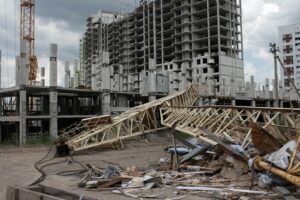Residents of ‘poorer’ neighbourhoods which have higher levels of air pollution are more likely to die prematurely, a new study has found.
Scientists at Ryerson University in Toronto, Canada found that poorer neighbourhoods of Toronto with fewer trees, higher levels of air pollution and lower-income levels generally had higher premature mortality rates than wealthier neighbourhoods.
They also found that ethnic minorities and indigenous people were disproportionately exposed to pollution.
The researchers say the findings emphasise a persistent problem of social injustice when it comes to people’s exposure to air pollution.
‘Generally speaking, greater pollution correlates with greater premature mortality,’ said Stephanie Melles, assistant professor in Ryerson’s Department of Chemistry and Biology and co-author of the study.
‘It’s also possible that the differences between where a person lives and where they work play a role in their overall exposure to pollutants.’
The scientists looked to investigate the link between premature mortality and various environmental, health, socioeconomic and demographic characteristics within the city of Toronto’s 140 neighbourhoods.
They found that residents of wealthy neighbourhoods have lower premature mortality rates owing to better tree cover and cancer screening.
In comparison, lower-income neighbourhoods with poorer tree cover, along with ‘walkable’ neighbourhoods, were often closer to industrial areas and had higher rates of premature deaths.
However, the researchers say they were surprised to find that high levels of ultrafine particles and industrial pollutants did not always correlate with higher premature mortality.
Some larger suburbs with higher pollution levels than downtown neighbourhoods had a decreased premature mortality rate of around 17 deaths per 100,000 — equivalent to smoking 125 fewer cigarettes per year — while some neighbourhoods with extensive green spaces had above average premature mortality rates.
The researchers put the anomalies down to a lack of air quality monitoring stations in Toronto, which makes it hard to know where and when its citizens are exposed to air pollution.
‘We need to collect more air quality data to create a more accurate picture of exposure,’ said Luckrezia Awuor, co-author of the study. ‘We also need more extensive environmental policies for better tree cover and greener spaces.’
The findings of the Ryerson study progress the argument that air pollution is as much of a social justice issue as much as an environmental one.
A recent study found that inequality in exposure to traffic-related air pollution in the UK has widened over recent years, with the poor polluting least but being polluted the most.
Photo Credit – Pixabay















